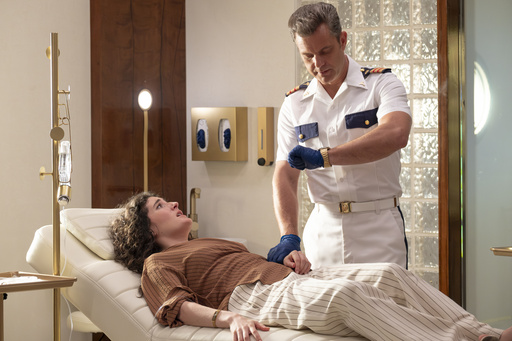
NEW YORK — Craig Sweeny found inspiration for a unique television series while he was driving, reflecting on how to infuse his personal touch into a medical drama. The concept struck him when he envisioned the legendary detective Sherlock Holmes, leading him to consider fusing elements of a hospital procedural with the intriguing world of Holmes. The outcome would feature a weekly medical mystery intertwined with narratives about Dr. John Watson, Holmes’ loyal companion, creating a captivating blend akin to the classic pairing of peanut butter and jelly.
“They are each worthy of their own show, and we are fortunate to harness both aspects, allowing them to vie for attention in a fascinating manner,” expressed Sweeny. This idea blossomed into “Watson,” a new CBS series that features Morris Chestnut as the lead character, who heads a team of medical investigators in a contemporary Pittsburgh setting populated with characters from Arthur Conan Doyle’s writings.
Sweeny, who previously executive produced and contributed to the writing of “Elementary,” a modern spin on the Holmes story, considers this project a moment of serendipity. “Watson” is not an isolated case among television networks that are revitalizing the classic procedural format. Although traditional series like “NCIS,” “FBI,” and “Chicago Med” form the backbone of today’s television landscape, innovative variations are emerging, capturing audience interest.
Among the new offerings is ABC’s “Doctor Odyssey,” which is set on a luxurious cruise ship and blends the medical procedural genre with the cruise experience. NBC introduces “The Hunting Party,” a series that creates a hybrid of “The Blacklist” and “Criminal Minds.” Meanwhile, CBS features Kathy Bates in “Matlock,” where she portrays an underestimated lawyer seeking revenge in her retirement years, challenging perceptions of a conventional role.
“There’s something inherently enjoyable about a self-contained, 43-minute narrative that provides a complete arc, a bit of mystery, and the satisfaction of solving a puzzle,” commented Jonathan Tolins, a playwright and showrunner. He believes that audiences’ familiarity with this format allows for rewards when writers introduce a creative twist.
Tolins’ own contribution to the evolving procedural format is CBS’s “Elsbeth,” which takes the quirky character Elsbeth Tascioni from “The Good Wife” and places her in a “Columbo”-inspired storyline. Portrayed by Carrie Preston, Elsbeth is a vibrant and unpredictable investigator who engages with a different guest star each week. Tolins emphasizes that the aim is to ensure Elsbeth does not dominate the screen, despite being the titular character, intentionally positioning her slightly away from the center in wide shots.
Another innovative procedural, ABC’s “High Potential,” features a single mother and a genius detective portrayed by Kaitlin Olson. The character stands out with an IQ of 160 and presents a whimsical challenge to her detective colleagues. “She’s quite unique,” said Todd Harthan, the executive producer, highlighting the character’s dynamic within the team.
As streaming services provide viewers with a curated selection of original series boasting renowned talent and high production values, they are influencing traditional television. “Inevitably, innovations from streaming impact network television, compelling us to adapt and compete in a constructive way,” noted Sweeny.
Procedurals are seen as comforting entertainment, delivering familiar narratives that promise resolution within an hour. This attachment to the format has encouraged streaming platforms to explore creative avenues, exemplified by shows like “Poker Face” on Peacock and Max’s “The Pitt,” which breaks down hospital drama into sequential hours akin to “24.”
Harthan believes that the distinction between streaming and network television is shrinking as networks grant writers more creative freedom while streaming platforms covet the extensive audiences that traditional television commands. “It’s essential to learn from different shows that diverge from one’s own work, as part of our growth in this industry,” added Harthan.
Showrunners advise that merging disparate elements in a series must be approached with care. Sweeny emphasizes that the premise of “Watson” is naturally fitting, given that the character was already a physician in the Sherlock Holmes narrative, making the adaptation to a medical setting seamless. “It’s an exotic combination, yet it feels entirely organic. There’s no need to force elements together; they inherently belong.”
The notion of a “gourmet cheeseburger” has been applied to premium shows on streaming platforms, and it appears that network television is entering a similar gourmet phase. “As the two spheres continue to align, the outcome can be beneficial,” expressed Robert King, co-creator of several notable shows on both platforms.
He and his wife, Michelle King, do not adhere strictly to the confines of network versus streaming when creating ideas; instead, they assess which format is a better fit for their narrative. Robert King cites “The Sopranos” as a prime example of a successful hybrid series that blended humor with serious themes, though it was initially pitched to a network.
“Elsbeth’s” creative team is encouraged by positive feedback regarding their approach to the procedural format. During a recent focus group for the new season’s premiere, viewers were surprised to discover the quality of network programming. “One participant exclaimed, ‘This is network? I need to watch more network television!’ which was gratifying for our team to hear,” Tolins reflected.

